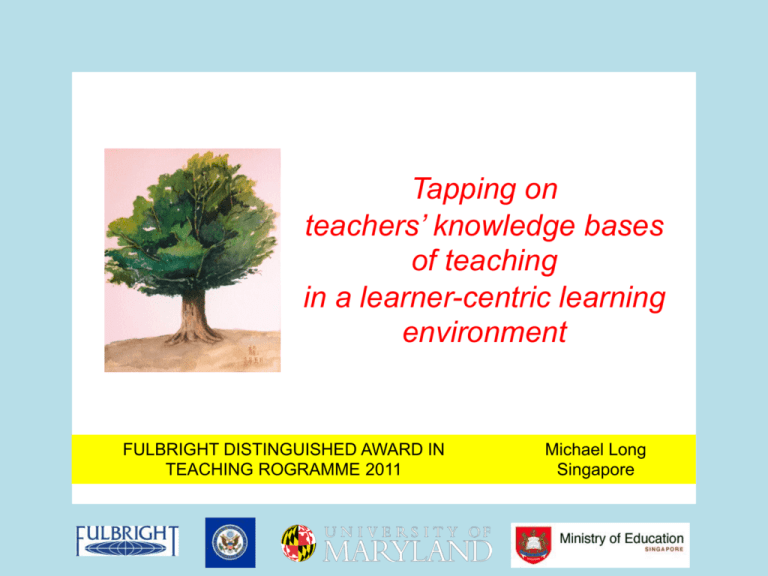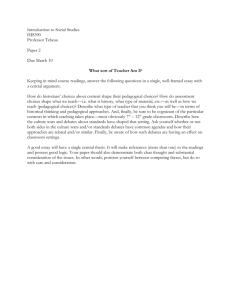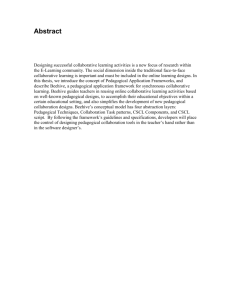Michael_Presentation
advertisement

Tapping on teachers’ knowledge bases of teaching in a learner-centric learning environment FULBRIGHT DISTINGUISHED AWARD IN TEACHING ROGRAMME 2011 Michael Long Singapore Introduction The quality of an education cannot exceed the quality of its teachers. ~McKinsey Report, 2007 Teaching is a performance. (Hooks, 1994; Fenstermacher & Richardson, 2005; Duckworth & Goodman in Hatton, 2005) The act of teaching and learning involves at least two persons; one who teaches and one who learns (Fenstermacher & Richardson, 2005) Issue • Every day : act of multi-tasking • Numerous initiatives : superficial acceptance and transfer, and don’t see the link Consequence Our learning at teachers’ training or professional development sessions becomes a figment of our memory especially when it is not fully internalised through active transfer and visible activities, and when the link is not made. Literature Review Six major sources that can account for the variance in students’ academic achievement: • • • • • • student (50% of the variance); teachers (30% of the variance). home (5 to 10% of the variance); schools (5 to 10% of the variance); peer effects (5 to 10% of the variance); principals, (already accounted for under the ‘schools’ category); John Hattie in Teachers Make a Difference: What Is the Research Evidence?(2003) (Stronge, 2010) Implication ‘Effective school learning requires good teaching, and good teaching requires professionals who exercise judgements in constructing the education of their students’. (Porter and Brophy, 1988) This judgement has to be supported by the whole professional knowledge base for teaching. My Intention To present to teachers a reference (or ‘script’) depicting the link of the fundamental knowledge bases necessary in building their competencies surrounding a learner-centric environment. As a reminder of the core of education of why we teach, what we teach and how we teach, as emphasised in the Teach Less, Learn More (TLLM) initiative, in raising the quality of teaching while engaging our learners’ hearts and minds to prepare them for life. Presentation of Findings LIFT THRUST DRAG WEIGHT Figure 1. Forces affecting the flight of an aircraft (Smithsonian Air and Space Museum) Desirable forces : Lift & Thrust (Enhance & accelerate performance) Undesirable forces : Drag & Weight (Impede & hinder performance) *Better understanding of pedagogical content knowledge (PCK) Opportunities for reflection Desirable class size - impact on marking load, quality of marking, monitoring of assignments and learning, relationship and character building Work-life harmony Sufficient time allocated for lesson observation by peer or mentor with time for conference and reflection Unsure of pedagogical content knowledge (PCK) Resistance to assessment Not sure of formative assessment Incomplete knowledge of the student as a learner Subject mastery/content knowledge Effectiveness of professional development programmes Leadership complement issue The desire to continue learning Clarity of leaders’ vision, drive, attitude and beliefs Knowledge of learning Self-concept (Attitude and beliefs of individual and the students) *Understanding the learner: dispositions, learning, cultural background/baggage Availability of resources/technology style of Having good instructional leaders Large teacher-student ratio Purposeful professional development programmes Lack of time for planning and reflection *Understanding assessment, its forms and purpose Lack of time and opportunity to observe others in the development of self (as peer) and others (as mentor) Seamless integration of subjects (e.g. science and literacy) School leaders as instructional leaders Salary issue Knowledge Bases for Teaching Content/Subject knowledge Models of teaching and learning General pedagogical knowledge Curriculum knowledge Knowledge of educational ends Pedagogical Content Knowledge (PCK) Knowledge of educational contexts Knowledge of learners Knowledge of self Figure 2. Adapted from Knowledge bases for teaching: the model (Turner-Bisset, 2001) Pedagogical Repertoire of an Effective Teacher Aspect 1 Strategies Activities Examples Analogies Illustrations Representations Aspect 2 Approaches Storytelling Socratic dialogue Drama Role-play Simulation Demonstration Modelling Problem-solving Singing Playing games Knowledge transformation Question-andanswer Instructing Explaining Giving feedback Figure 3. Pedagogical repertoire (Turner-Bisset, 2001) Aspect 3 Acting skills and strategies Voice Vocal animation Body language Physical animation Use of space Humour Role-play Use of props Surprise Suspense Observing children To teach Facts Concepts Skills Processes Beliefs Attitudes Organisation al strategies Whole-class Split-class Large group Small group Pair Individual Pedagogical Repertoire on a Foundation of Knowledge Bases Aspect 1 Strategies Activities Examples Analogies Illustrations Representations Aspect 2 Approaches Storytelling Socratic dialogue Drama Role-play Simulation Demonstration Modelling Problem-solving Singing Playing games Knowledge transformation Question-and-answer Instructing Explaining Giving feedback Aspect 3 Acting skills and strategies Voice Vocal animation Body language Physical animation Use of space Humour Role-play Use of props Surprise Suspense Observing children To teach Facts Concepts Skills Processes Beliefs Attitudes Organisational strategies Whole-class Split-class Large group Small group Pair Individual Knowledge Bases Substantive knowledge, syntactic knowledge and beliefs about the subject Curriculum knowledge and knowledge of educational ends Models of teaching and learning and general pedagogical knowledge Knowledge of educational contexts Knowledge of self Knowledge of learners Pedagogical content knowledge Figure 4. Adapted from a pedagogical repertoire (Turner-Bisset, 2001) The ‘Script’ Classroom Management & Organisation Instructional models & strategies Assessment & Educational Ends (Goals, purposes & values) and Beliefs Reflective practices Representations Enactive General Pedagogical Knowledge & Beliefs Iconic Symbolic Quality relationship building Knowledge of Learners and Learning & Beliefs Empirical/Social Interests Community Cognitive Strengths Generic Specific Breadth Pedagogical Content Knowledge & Beliefs Structure Scope Purpose Curriculum Knowledge & Beliefs Content Knowledge & Beliefs Substantive (Knowing that) Knowledge of Specific Contexts (Subject & Environment) Syntactic (Knowing how) Home Knowledge of General Educational Contexts School Community Values Bloom, Gagne, etc Balance Classroom SelfConcept Will & Effort Depth Classroom Communication & Discourse Assessment Models of Learning Theories Constructivist (Vygotsky, Piaget, Dewey, Bruner) Behaviourist (Pavlov, Skinner, Watson) Cognitive (Sweller, Mayer) Motivation (Maslow, Keller) Formal Informal Social Learning (Bandura) Others: Transformative, Networked, etc. Figure 5. Adapted from Gess-Newsome and Lederman (1991), Moore (2000) and Turner-Bisset (2001) Country World Conclusion • Learning is guided by social interaction and strategies that evolve within the ‘process of doing’. (Moll, et al, 1992) • The teacher holds the key in constructing an environment surrounding the learners that can support or impede this realisation. • The knowledge bases of teachers guide and inform decisions to be made and actions to be taken. Accountability is an ‘outside-in’ process while responsibility is an ‘inside-out’ process. (Powell, 2010) Thank You’s UMD Faculty Members • Dr James Greenberg • Dr Letitia Williams • Dr Jim DeGeorge • Dr Diane Jass Ketelhut • Dr Linda Valli • Dr Margaret Anne Walker • Dr Ann Schweighofer • Megan, Beth, and Andy All schools I have visited, in particular, Paint Branch Elementary; special thanks to Dr Teston, Mrs Harris, Mrs Hunt and Ms Flores. The FHI360 family, and the U.S. Department of State, the Bureau of Educational and Cultural Affairs. End






